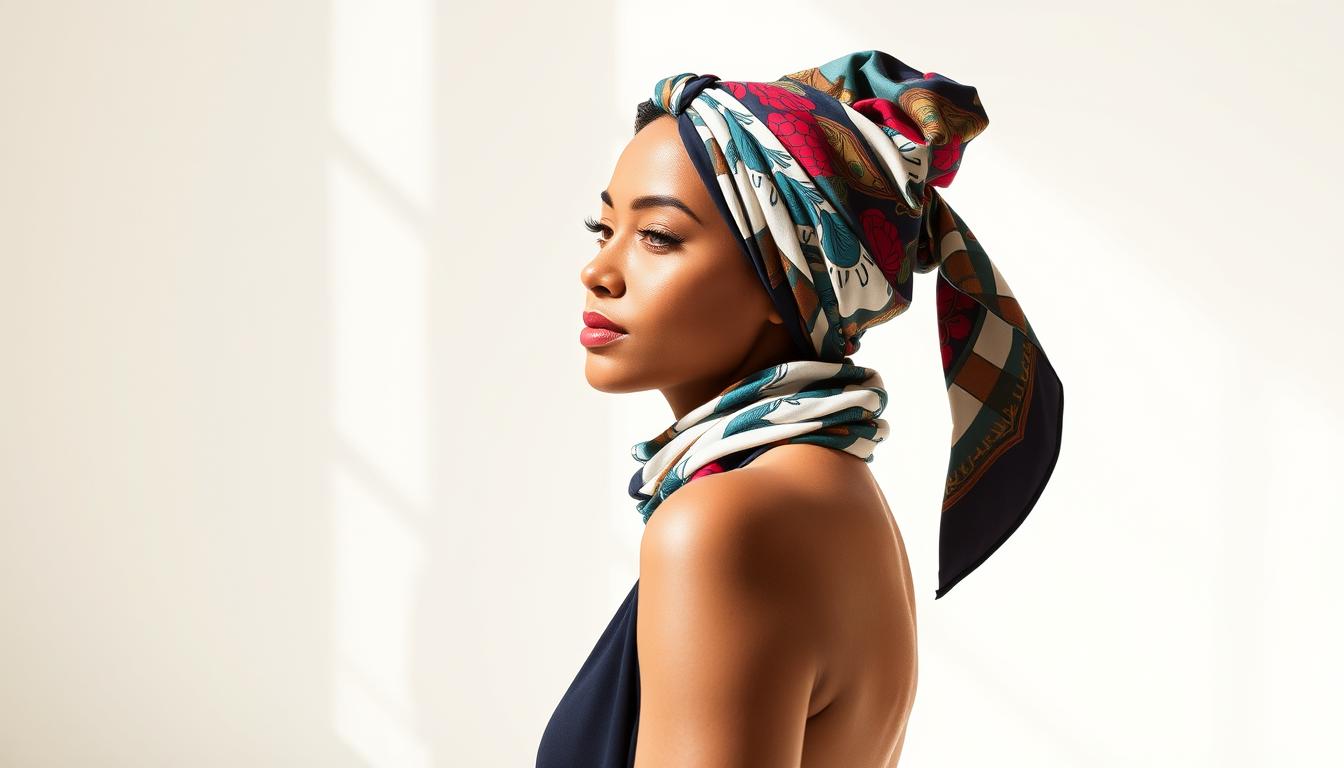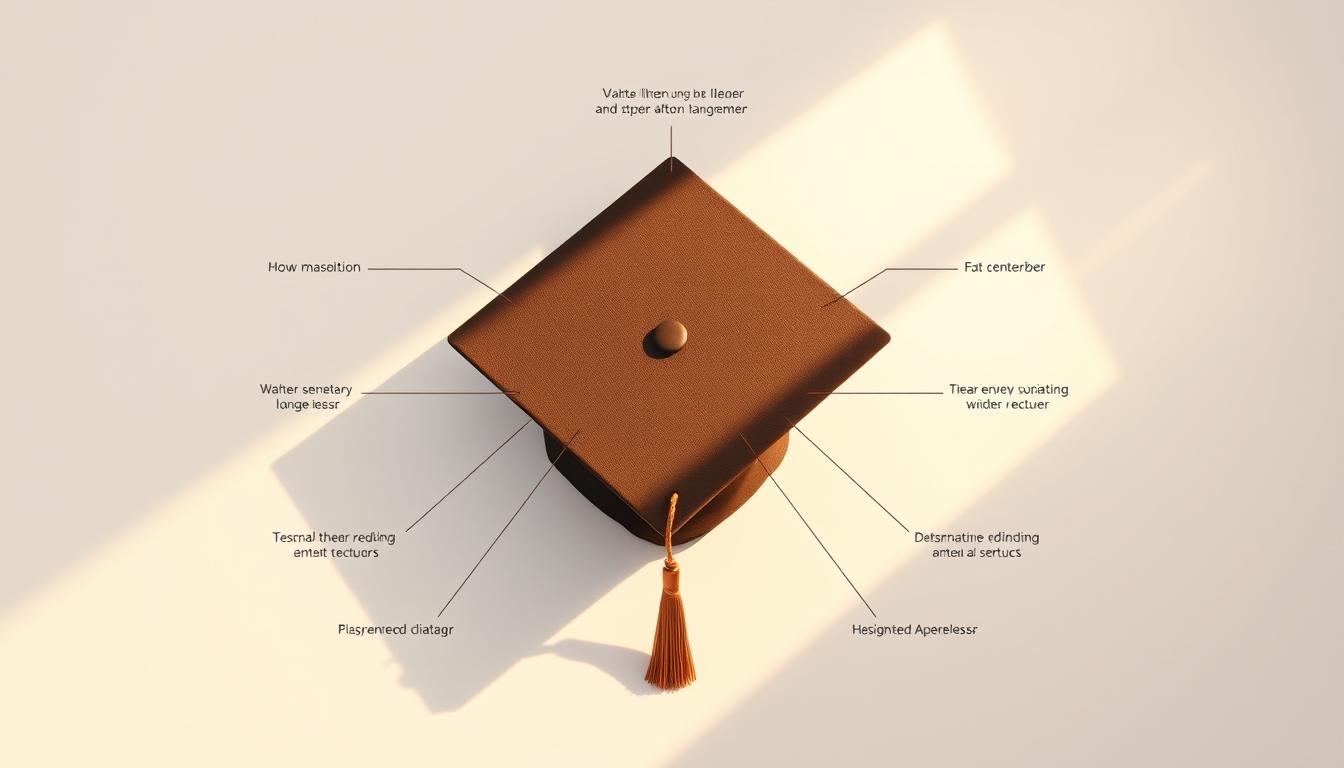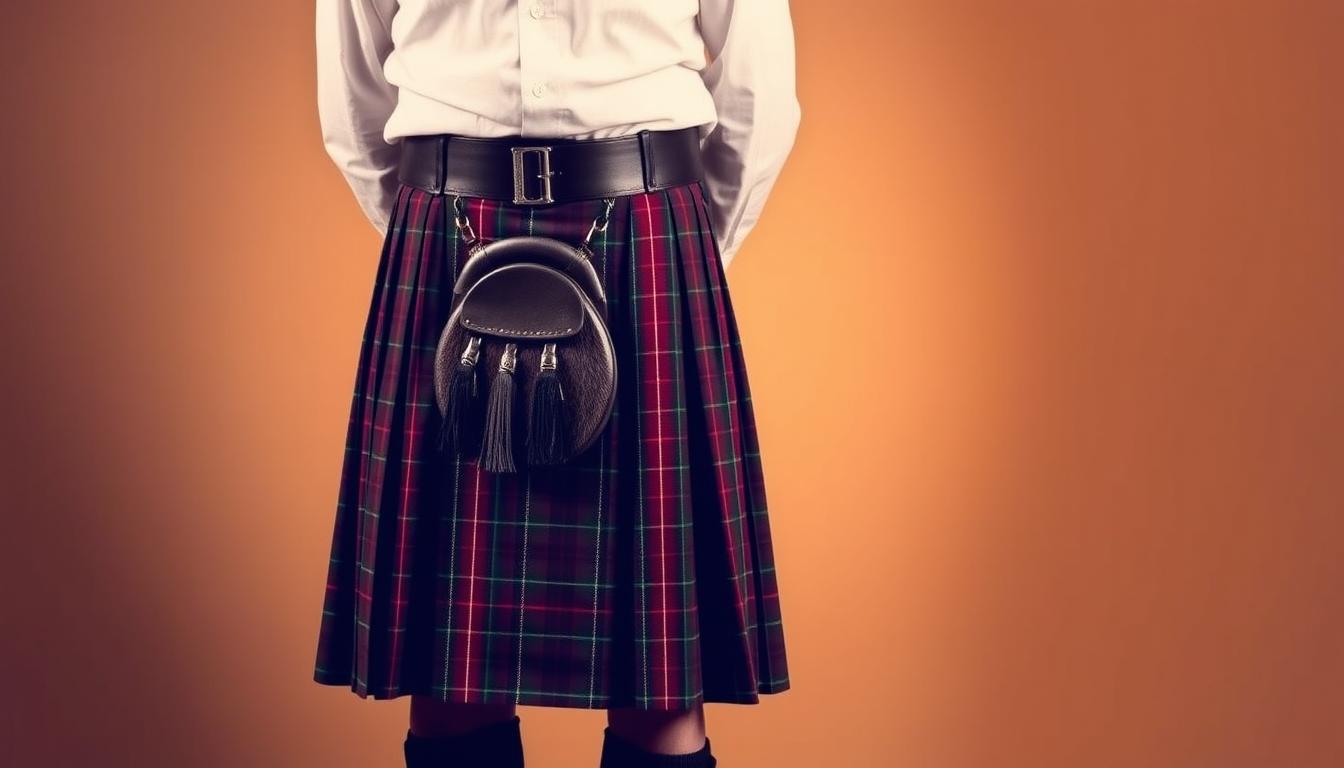Learning to wear a kimono is like unlocking a cultural treasure. This traditional dress is more than clothes; it’s a stunning art form. It connects Japan’s past with today’s fashion.
At first, wearing a kimono might seem hard. But with the right help, anyone can learn. The wrapping, folding, and choosing accessories are both tough and rewarding. Each kimono has its own story, told through colors, patterns, and materials.
Your kimono journey starts with knowing its parts and meaning. From formal to casual, kimonos are versatile. They can make any outfit special.
Key Takeaways
- Kimonos are complex garments with deep cultural roots
- Proper wearing technique requires practice and patience
- Different styles suit various occasions and seasons
- Accessories play a critical role in completing the kimono look
- Understanding cultural context enhances kimono appreciation
Understanding the Traditional Japanese Kimono
The traditional Japanese kimono is more than just clothes. It’s a cultural treasure that shows centuries of art and social meaning. Let’s explore the design, meaning, and skill that make kimonos so special.
Kimonos are a language of their own. They show status, occasion, and personal style. Each design tells a story about the wearer’s identity and their place in society.
Exploring Different Kimono Types
Not all kimonos are the same. Each style has its own purpose and reflects different social settings:
- Furisode: Formal kimono for unmarried women, featuring long flowing sleeves
- Yukata: Casual summer kimono, typically made of lightweight cotton
- Tomesode: Formal kimono for married women, with more restrained designs
- Hakama: Kimono-style trousers often worn for martial arts or formal occasions
Seasonal Kimono Variations
Japanese culture celebrates the seasons through kimono designs. Summer kimonos are light and breathable. Winter kimonos are thick and warm, with detailed layering.
Kimono Materials and Fabrics
The choice of kimono materials is both beautiful and practical. Traditional fabrics include:
- Silk – most prestigious and formal
- Cotton – comfortable and practical
- Wool – perfect for cooler seasons
- Synthetic blends – modern, easier to maintain
Knowing these details turns the kimono into a living piece of cultural heritage.
Essential Components of a Kimono Outfit
Exploring the world of traditional kimono reveals its detailed parts. A kimono is more than just a piece of clothing. It’s a complete set that needs several items to look amazing.
Let’s look at the main kimono accessories that make this traditional outfit stand out:
- Juban: The essential undergarment worn beneath the kimono
- Obi: The decorative sash that cinches the kimono
- Koshihimo: Thin cords used to secure the kimono layers
- Datejime: A middle layer that helps maintain the kimono’s shape
Each part is vital in making the perfect traditional kimono. The way these accessories are layered and arranged turns a simple outfit into a masterpiece.
| Kimono Component | Purpose | Significance |
|---|---|---|
| Juban | Inner layer protection | Prevents outer kimono from direct skin contact |
| Obi | Waist support and decoration | Defines silhouette and adds visual interest |
| Koshihimo | Securing layers | Ensures kimono stays in place |
| Datejime | Shape maintenance | Creates smooth, elegant lines |
Knowing these parts is essential for mastering the kimono. Each piece adds to the kimono’s beauty and authenticity.
Preparing to Wear Your Kimono
Wearing a kimono is an art that needs careful prep. Before we dive into how to wear one, setting up for success is key. Our tips will help you get ready for your traditional Japanese outfit.
Essential Undergarments for Kimono Dressing
The right undergarments are essential for a perfect kimono look. When learning to wear a kimono, focus on these basics:
- Hadajuban: A thin, soft undergarment for next to the skin
- Nagajuban: A longer undergarment for structure
- Soft, seamless undergarments for a smooth shape
Taking Precise Measurements
Getting accurate measurements is vital for a great kimono fit. Our kimono styling tips suggest measuring:
- Height from neck to ankle
- Shoulder width
- Chest and waist size
- Arm length
Creating Your Ideal Dressing Space
Set up a clean, spacious area with good lighting and a full-length mirror. Have all your accessories ready. A tidy space makes dressing up smoother and more fun.
Pro tip: Have a soft, flat area for your kimono and accessories. This prevents wrinkles and keeps everything handy while dressing.
How to Wear a Kimono: Step-by-Step Process
Learning to wear a kimono might seem hard, but we’ll make it easy. We’ll show you how to wear this beautiful traditional garment step by step. It’s all about precision and technique.
First, get ready with your undergarments. You’ll need:
- A thin white undergarment called hadajuban
- An outer undergarment known as nagajuban
- Soft, smooth-fitting undergarments for a smooth look
Here are the key steps to wear a kimono:
- Start with your hadajuban, making sure it’s smooth
- Then, wear your nagajuban around your body, keeping it centered
- Next, unfold your kimono and hold it by the shoulders
- Wrap the right side over your body first (left side for the deceased)
- Adjust the collar to sit about one inch below your neck
For a pro look, keep the kimono straight and smooth. Take your time to adjust for a perfect fit. Wearing a kimono is an art that needs patience and practice.
It’s important to keep the kimono balanced and smooth. Move with grace, showing the elegance of this traditional Japanese garment.
Mastering the Art of Tying an Obi Belt
Tying a kimono belt is an art form that changes your kimono styling experience. The obi is more than just an accessory. It’s the centerpiece that can make your outfit go from basic to breathtaking.
Our kimono styling tips will guide you through the world of obi belt tying. You’ll learn with confidence and grace. The right technique is key to a stunning traditional look.
Basic Obi Knot Styles
Let’s look at the most popular obi knot styles:
- Taiko Musubi: The classic drum knot for formal occasions
- Fukura Suzume: A sophisticated knot that looks like a plump sparrow
- Bunko Musubi: An elegant, book-like folded style for semi-formal events
Common Mistakes to Avoid
Even experienced people can make these mistakes when tying a kimono belt:
- Pulling the obi too tight, which restricts movement
- Creating an uneven or asymmetrical knot
- Choosing the wrong knot style for the occasion
- Neglecting the proper underlayers that help shape the obi
Pro tip: Practice is key for mastering kimono styling tips. Start with simpler knots and move to more complex ones. Each try will make you better and more confident.
Modern Ways to Style a Kimono
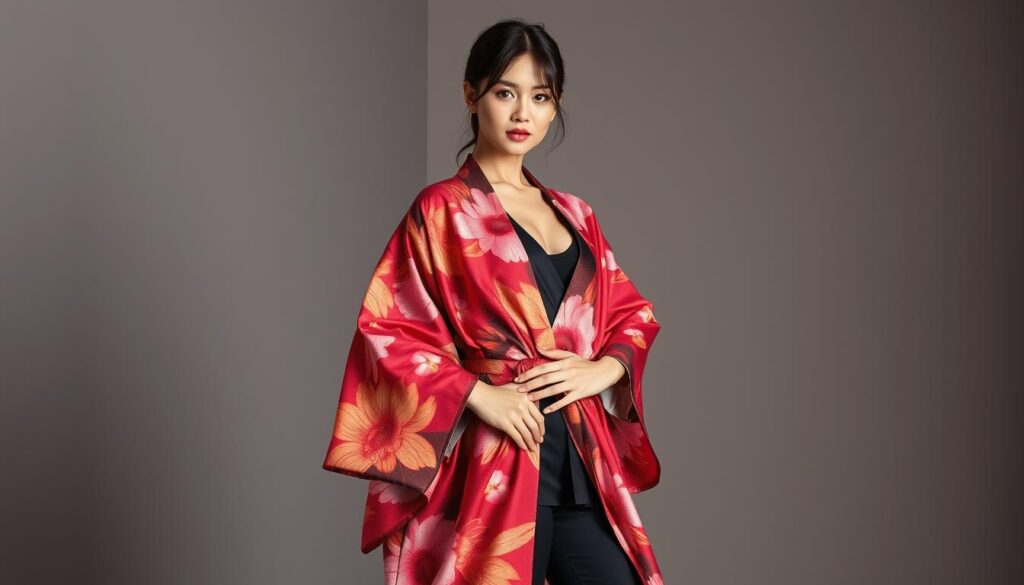
Adding a modern kimono to your wardrobe is easy. We have some cool kimono outfit ideas that mix old-world charm with today’s street style.
Kimono styling has changed a lot. Now, it’s not just for formal events. People are wearing it in new ways that show off their style and respect for tradition.
- Pair a lightweight silk kimono with skinny jeans and ankle boots for an effortless casual look
- Layer a structured kimono jacket over a monochromatic work outfit for professional chic
- Use a vibrant kimono as a beach cover-up or summer festival statement piece
- Transform your evening wear by draping a luxe velvet kimono over a little black dress
When looking at modern kimono fashion, think about fit and fabric. Lightweight materials like chiffon and soft cotton are great for daily wear. But, structured brocades are perfect for evening looks.
| Style Category | Recommended Kimono Type | Ideal Pairing |
|---|---|---|
| Casual Day Out | Cotton Kimono Jacket | Distressed Denim, White Tee |
| Office Wear | Tailored Silk Kimono | Pencil Skirt, Fitted Blouse |
| Evening Glam | Velvet Kimono | Cocktail Dress, Strappy Heels |
The secret to great kimono outfits is confidence. Try different colors, textures, and styles. Show off your unique taste while honoring the kimono’s cultural history.
Selecting the Right Footwear and Tabi Socks
Choosing the right footwear and tabi socks is key to a complete kimono look. These accessories are vital for an authentic and stylish outfit. Knowing the traditional and modern options can take your kimono style to the next level.
Traditional Footwear Choices
Traditional kimono footwear offers unique styles. The most iconic choices include:
- Zori: Elegant formal sandals made from rice straw or fabric
- Geta: Wooden sandals with raised platforms, perfect for outdoor events
- Traditional leather sandals with detailed designs
Contemporary Footwear Options
Modern kimono outfits offer versatility with new footwear. Fashion lovers can try:
- Sleek leather loafers
- Minimalist designer sandals
- Comfortable ballet flats
Sizing and Fit Guidelines
| Footwear Type | Sizing Recommendation | Comfort Level |
|---|---|---|
| Traditional Zori | Precise fit, minimal wiggle room | Medium |
| Geta Sandals | Slightly larger for toe movement | High |
| Modern Alternatives | Standard shoe sizing | Very High |
When picking tabi socks, focus on comfort and fit. These socks should be snug yet breathable. They should enhance your kimono look perfectly.
Essential Kimono Accessories and Their Significance
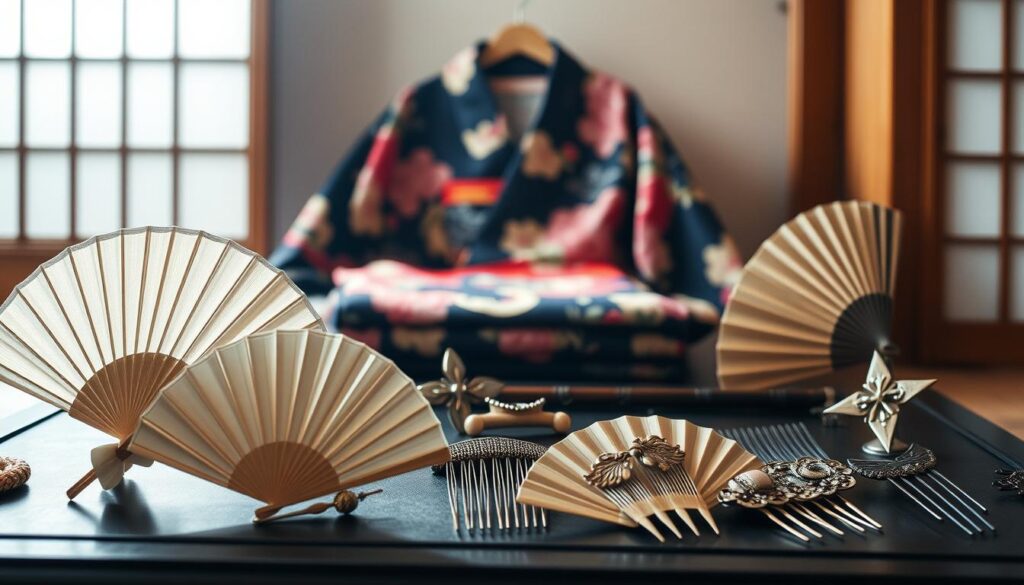
Kimono accessories are more than just decorations. They hold deep cultural significance. Each piece has its own story, adding depth to traditional Japanese attire.
Let’s look at the key kimono accessories that make a simple garment into a stunning cultural statement:
- Kanzashi: Intricate hair ornaments that showcase incredible craftsmanship
- Obijime: Decorative cords that secure the obi and add visual interest
- Obiage: Silk scarves that provide additional elegance to the outfit
- Tabi socks: Traditional split-toe socks worn with kimono footwear
Understanding kimono accessories means appreciating their symbolic meanings. Each piece carries cultural significance beyond mere decoration.
| Accessory | Cultural Meaning | Typical Material |
|---|---|---|
| Kanzashi | Represents seasonal changes and personal status | Silk, metal, tortoiseshell |
| Obijime | Indicates formality and personal style | Silk, braided cord |
| Obiage | Signals social occasion and personal taste | Silk, embroidered fabrics |
Choosing the right kimono accessories can take your outfit to the next level. It turns a simple kimono into a personal statement of style and cultural appreciation.
Kimono Color Symbolism and Patterns
The traditional kimono is more than a piece of clothing. It’s a canvas filled with cultural significance. Its colors and patterns tell stories, making the kimono a visual language of Japanese traditions.
Exploring the colors of a kimono offers a peek into Japanese culture. These colors don’t just look good; they convey messages about social status, emotions, and the seasons.
Traditional Color Meanings in Kimono Design
- Red: Symbolizes passion, celebration, and energy
- White: Represents purity, mourning, and spiritual cleansing
- Black: Signifies formality and sophistication
- Blue: Indicates tranquility and depth of character
Seasonal Pattern Guidelines
The kimono also reflects the seasons. Its patterns mirror the natural world and its changes.
| Season | Typical Patterns | Symbolic Meaning |
|---|---|---|
| Spring | Cherry blossoms, butterflies | Renewal and hope |
| Summer | Water motifs, dragonflies | Coolness and resilience |
| Autumn | Maple leaves, chrysanthemums | Transition and reflection |
| Winter | Pine trees, snow crystals | Strength and endurance |
Learning about kimono colors and patterns reveals its true value. It’s not just clothing; it’s a living artwork that connects people across generations through its stories.
Occasion-Specific Kimono Etiquette
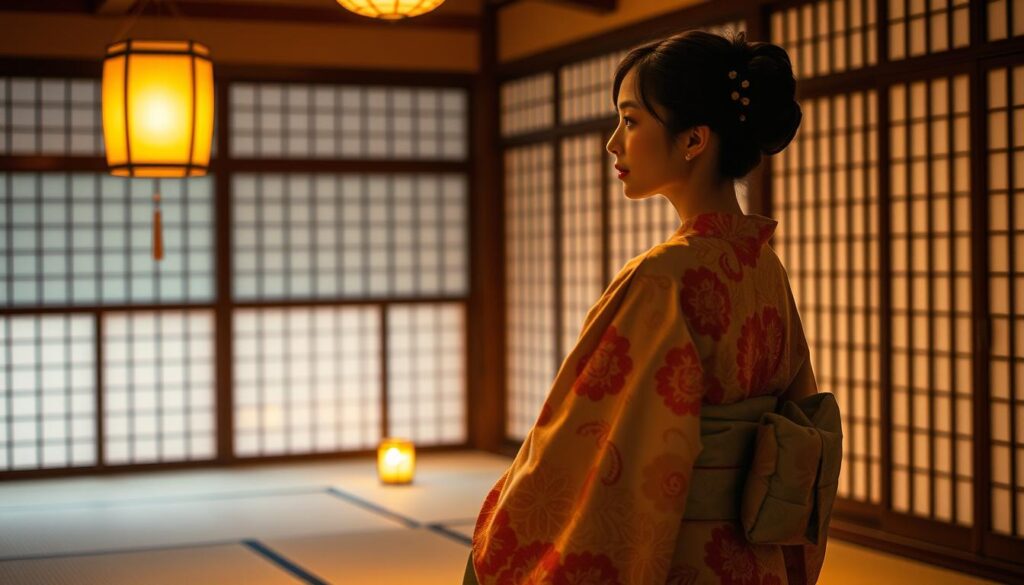
Wearing a kimono is more than just fashion. It’s about respecting Japanese traditions. Each occasion has its own kimono style and etiquette.
Choosing the right kimono for special events is important. For weddings, tea ceremonies, and cultural festivals, the dress code varies.
- Weddings: Choose subdued colors and elegant patterns
- Tea Ceremonies: Select kimonos with minimal, refined designs
- Festival Events: Embrace brighter, more vibrant kimono styles
Here are key etiquette tips for wearing a kimono at special events:
- Respect traditional color symbolism
- Match your kimono to the event’s formality
- Consider seasonal appropriateness
| Occasion | Recommended Kimono Style | Color Considerations |
|---|---|---|
| Formal Wedding | Tomesode | Neutral tones, black preferred |
| Cultural Festival | Yukata | Bright, seasonal colors |
| Business Event | Visiting Kimono | Subdued, professional shades |
By following these guidelines, you’ll show respect for Japanese culture. You’ll be perfectly dressed for any event.
Maintaining and Storing Your Kimono
Keeping your kimono in top shape is key. It can last for generations, becoming a treasured family heirloom. It tells a story of skill and cultural heritage.
Proper care is more than just cleaning. Your kimono is a piece of Japanese textile art. It needs special care techniques.
Professional Cleaning Approaches
There are specific cleaning methods for your kimono:
- Professional dry cleaning for silk kimonos
- Gentle spot cleaning for minor stains
- Hand washing for specific cotton and lightweight fabrics
- Avoiding direct sunlight during cleaning process
Storage Best Practices
Storing your kimono right keeps it looking great:
| Storage Method | Recommended Technique |
|---|---|
| Hanging | Use padded hangers to prevent shoulder stretching |
| Folding | Wrap in acid-free tissue paper to prevent creasing |
| Environment | Store in cool, dry place with minimal humidity |
Follow these tips to keep your kimono looking amazing for years.
Common Challenges and Solutions
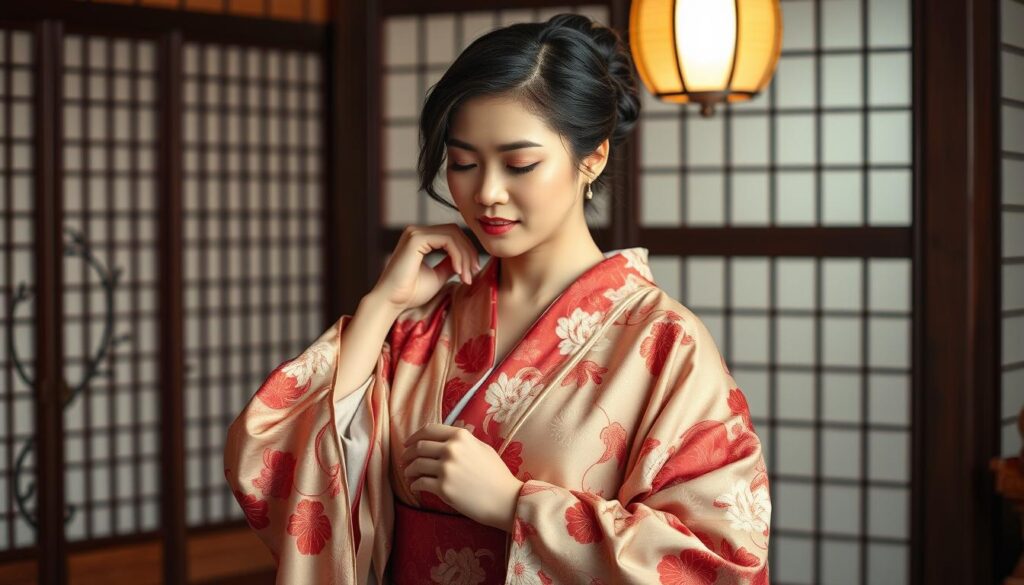
Learning to wear a kimono can be tough for beginners. Our tips will guide you through common problems with ease and elegance.
Wearing a traditional kimono comes with its own set of challenges. You’ll need to keep layers in place and manage the fabric’s movement. Each step requires focus and care.
- Layer Slippage Prevention
- Sleeve Management Techniques
- Obi Belt Adjustment Strategies
- Comfortable Sitting Positions
Understanding how fabrics behave is key to styling a kimono. Our expert advice will turn fashion mistakes into stylish moments.
| Challenge | Solution |
|---|---|
| Loose Inner Layers | Use specialized kimono clips and undergarment fasteners |
| Long Sleeve Management | Practice controlled arm movements and strategic folding |
| Uneven Hem | Use internal weight strips for consistent draping |
Pro tip: Practice makes perfect when learning how to wear a kimono. Start with lighter fabrics and simpler styles to build your confidence.
Every kimono-wearing pro began where you are now. With patience and practice, you’ll master these challenges in no time.
Blending Traditional and Contemporary Styles
Modern kimono fashion has changed a lot. It’s now a style statement that mixes old traditions with new trends. We focus on making unique, personalized looks. These looks honor the kimono’s history while staying current.
To wear kimono in everyday life, you need creativity and a good eye for style. We’ll show you how to add these stunning garments to your wardrobe:
- Layer a lightweight kimono jacket over slim-fit jeans and a basic tee
- Use an obi belt to cinch a modern wrap dress
- Pair a cropped kimono-inspired blazer with high-waisted trousers
Street Style Integration
Street fashion is perfect for trying out modern kimono looks. It lets you mix traditional Japanese style with today’s shapes. Imagine wearing oversized kimono coats with sneakers or delicate silk tops with leather pants.
Fashion-Forward Combinations
To make kimono outfits stand out, you need to break some rules. But always respect the garment’s cultural value. Try these bold pairings:
- Silk kimono jackets with graphic tees
- Traditional patterns on modern streetwear pieces
- Mixing textile textures for visual interest
The secret is finding balance. Mix kimono pieces with modern items that show off your style. This way, you honor the kimono’s heritage while staying trendy.
Cultural Considerations When Wearing a Kimono
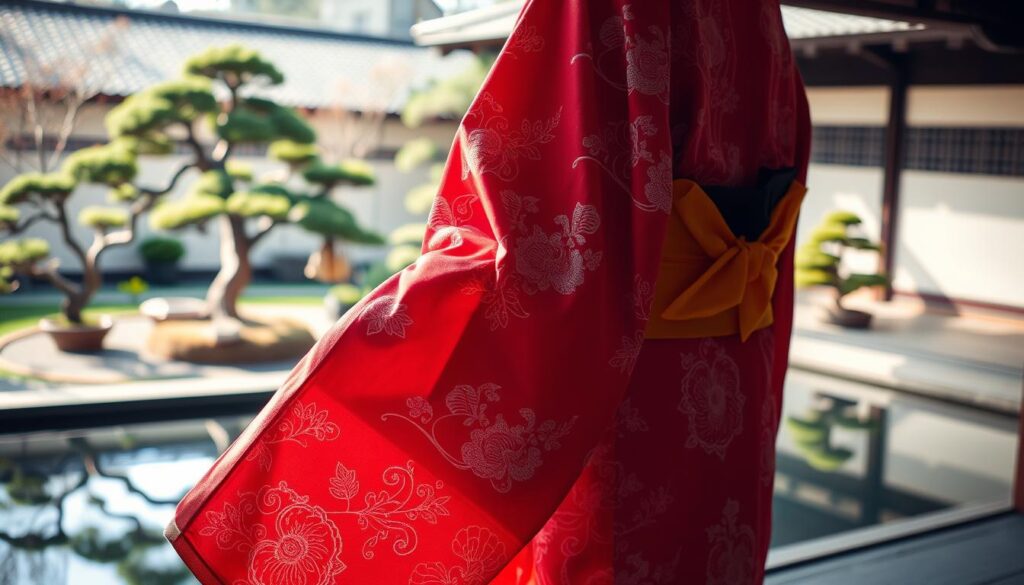
Wearing a kimono is more than just fashion. It’s a deep dive into Japanese culture and history. It’s a garment that holds centuries of tradition and heritage.
Kimono wear is an art that needs respect and understanding. Our guide will help you balance cultural appreciation and avoid mistakes.
- Research the historical context of kimonos before wearing one
- Understand the symbolic meanings behind different patterns and colors
- Recognize the deep cultural roots of this traditional dress
Exploring kimono culture means following some key principles:
- Approach the traditional dress kimono with genuine respect
- Learn about the cultural context and traditions
- Avoid using kimonos as casual costume or Halloween attire
- Seek to understand the garment’s deeper meaning
Cultural sensitivity turns wearing a kimono into a meaningful cultural experience. By being mindful, you show true respect for Japanese heritage.
Each kimono has its own story. The designs, fabrics, and construction show generations of art and culture.
Where to Buy Authentic Kimonos
Finding the perfect traditional dress kimono is easier with the right guide. We’ve put together a detailed guide for those looking for real kimono outfit ideas. It shows where to find them from trusted sources.
Japan is the best place to find authentic kimonos. Stores in Kyoto and Tokyo have amazing selections. They show off incredible craftsmanship. If you can’t travel, many online shops offer great options too.
- Rakuten Japan – Direct marketplace for traditional kimono designers
- Kyoto Kimono Rental – Offers purchasing options alongside rental services
- Japan Objects – Curated online store featuring authentic Japanese textiles
When looking for kimonos, keep these tips in mind:
- Make sure the fabric is high quality
- Look for authentic maker’s marks
- Learn about traditional construction methods
- Check the return and authenticity policies
Digital platforms have made kimonos more accessible. Now, fashion lovers around the world can explore traditional kimono styles. Vintage markets and boutiques are great for finding unique pieces with deep cultural stories.
If you’re on a budget, try Etsy or Japanese resale sites. You can find amazing deals. Prices vary from $200 to $5,000, based on the craftsmanship and history.
Conclusion
Learning how to wear a kimono is like mastering an art form. It mixes cultural respect with personal style. We’ve covered everything from its history to modern ways to style it. Now, you have the key tips to make wearing a kimono a bold fashion statement.
Every step in wearing a kimono is more than just dressing up. It’s about connecting with a long tradition and showing your unique style. The art of wrapping, tying, and adding accessories shows the skill behind this traditional clothing. Whether for a formal event or daily wear, you’re set to explore this elegant fashion world.
Enjoy the elegance, respect the tradition, and most importantly, have fun with your kimono journey. Fashion is about expressing yourself, and with these tips, you’re ready to create looks that honor Japanese culture and show off your style. Your kimono adventure begins now – wear it with pride, creativity, and confidence.



